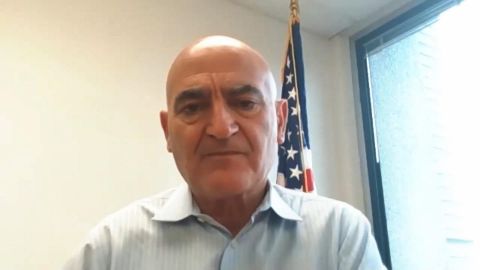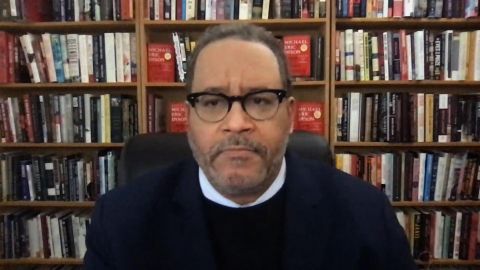Read Transcript EXPAND
CHRISTIANE AMANPOUR: And, all week, we have been updating you on the grim records the United States has been setting in deaths, hospitalizations, and now surpassing 14 million cases. Dr. Moncef Slaoui is the chief scientist in charge to Operation Warp Speed, which is the federal program that helped get the vaccine to the United States market in record time. And here he is talking to our Walter Isaacson about the key issue, safety.
(BEGIN VIDEOTAPE)
WALTER ISAACSON: Thank you, Christiane. And, Dr. Slaoui, thank you for coming on the show, and thank you for all you have been doing.
SLAOUI: Thank you for having me.
ISAACSON: We have been slammed in the past few weeks with another surge of coronavirus, a person dying every minute. So, tell us. Next week, next Wednesday, when the FDA committee meets and the Wednesday after that, do you think we’re going to get the Pfizer and then the Moderna vaccines?
SLAOUI: Well, listen, I hope we will have the approvals very quickly after the meeting. However, it’s important to note that the FDA process is totally independent from the operation. And we did that by design to make sure that the independent regulatory body functions appropriately. I am sure that the review that is being made is very thorough and very deep, and I’m sure they are doing everything possible to reach a quick conclusion. I expect it to be positive. The data, frankly, are remarkable. You know, what’s really powerful is the fact that two vaccines using similar technologies, but acting slightly different, broadly similar technologies, developed independently, tested independently in two large trials, come up with almost identical outcome on many different levels. To me, it’s an enormous reassurance that the data are real, are extremely robust, both on the effects of the vaccine and on the safety.
ISAACSON: And it’s particularly interesting because these are vaccines that have never been proven before, which is just sticking messenger RNA in our cells and having our cells produce those spike proteins. That’s never been done before, right?
SLAOUI: This indeed has never been done as an approved product. There have been many different clinical trials for different diseases using this technology on a few hundred individuals at a time over the last, I would say, at least four years or five years. But there has never been a product approved. I think now we have experience in 70,000 or so people immunized with this platform technology between the two companies. And, really, the data are very reassuring in terms of the short and midterm safety of this vaccine. And what we know is the short and midterm safety are predictive of the long-term safety.
ISAACSON: So, you can tell people, just look right into the camera and say, trust us now, we have tested this, these seem very safe, as safe as any other vaccine?
SLAOUI: Here’s what I say. Every single data I have seen on the toxicology and animal work that assess potential harm and biological reason for harm show that there is none, and it’s very similar to other vaccine. All the data I have seen on the safety of the vaccine in the clinical trial shows that the efficacy is outstanding and the safety is similar to that of many other approved vaccines. And there — and all the data I have seen from other vaccine shows that, when safety is clear in the first 60 or 90 days after starting immunization — this is one of the reasons the FDA asked for 60 days after completion of immunization — that data is predictive of long-term safety. And it’s the case here. That is one part of the equation. I think it’s important for us to realize the other part of the equation. Unfortunately, we have more than 2,000 people dying every day, and 100,000 people in hospital. Our life has been turned around. We can’t work. We can’t go to school. Everything is stalled. That’s the risk we know. There is maybe a conceptual risk that one person out of a million may have a problem. It’s impossible to predict. The only way to know it is to do it. And in using the vaccine, we will prevent all the harm I just described that we know. And, therefore, I will be the first, as soon as I’m authorized, to take the vaccine and give it to my family, absolutely.
ISAACSON: You say that we know the short and medium term. We have already tested it. People like myself have been in trials in 60, 90 days. Is there anything in the science of putting RNA and people cells that could conceivably make it more dangerous longer-term than other type of vaccines?
SLAOUI: There really isn’t. What people need to understand is, RNA is not DNA. DNA, people could conceptually say, oh, it may stick around somewhere and then link to your DNA and do some change. RNA is designed to be destroyed. In fact, a lot of the work that the companies have done, BioNTech or Moderna, has been about protecting that RNA from being instantly destroyed as soon as it gets in our body. When the RNA gets into the cell, it lives for a little bit. It helps as a template to make the antigen, and then it’s gone. It’s gone from the cell. The cell produces the antigen, spits it out. The immune system itself comes and deals with that cell because they think it’s like a virus. And it’s all gone. And that’s really what the data shows, is that, over time, you can’t detect the RNA anymore. So, it’s actually a remarkably fast and effective technology. What we — what happens in — with these vaccines is, we trick ourselves to produce exactly the same antigen as if they had the virus in them. And that’s very hard to reproduce when we produce the vaccines in a big fermenter. That’s really what made this technology so fast and so effective now.
ISAACSON: The Pfizer vaccine, in particular, requires super cold supply — super cold distribution chains, and even the Moderna one does. You’re working with the Army. Tell me, how are these things — if next Wednesday and the Wednesday after, it gets authorization, how are we going to get it to places like New Orleans?
SLAOUI: So, it’s really worked out in every single detail over the last several months. We have planned. We — what I mean by we is the operation, but within the operation, frankly, my co-leader, General Perna, and all the experience of the — and insights and capabilities of the Department of Defense have planned it to the minute how vaccine doses will be transported from where they are manufactured to the immunization spot areas that each state will have indicated to us. In fact, yesterday, with General Perna, we visited UPS Healthcare. UPS will be one of the transportation strategies. UPS delivers millions and millions of parcels every day everywhere, to every zip code in the U.S. And they will do likewise with the vaccine. FedEx will do the same thing. We also visited some of the warehouses in which the vaccine parcels will be directed in virus direction. Yesterday, also, more than 70 different vaccine parcels have been sent empty to test, right, all the system. I think we have worked out, with Pfizer and with Moderna, the process to deliver this vaccine using what already exists. Every year, 80 million to 100 million doses of influenza vaccine are distributed in the same way, using the same routes, the same transporters, the same warehouses that we’re using for this vaccine. So, that makes us confident that it should be OK.
ISAACSON: But Pfizer just indicated and may have to cut back quite a bit on its first few months of delivery. Why did that happen? And how can we get confidence that this — this is — after all the testing fiascoes we have had, confidence that we can lick this delivery system?
SLAOUI: Right. So, I frankly don’t know exactly what happened, if anything happened at Pfizer. What I know is, we have an agreement with Pfizer for receiving a certain number of doses. And those are the number of doses we are receiving here in the USA. I think the issues, if they have happened, have nothing to do with distributing the vaccine. They have to do potentially with manufacturing it. I do want to stress, because I think it’s very important to realize, that these manufacturing technologies are unbelievably complex and very different than making a phone or a car, because this is engineering. Those vaccines are biology. And biology, we don’t control as well as engineering. So — and it takes months and months for a batch to go from starting point to actually making sure it has all the quality criteria before you can use it in humans. And we just have industrialized all of that process. And there could be glitches. And I think the best way to deal with that is to be transparent about it, if and when it happens, and explain how we recover from it. The good news, frankly, is each batch makes about one to two million doses. There’s a glitch in one batch, it doesn’t change. Overall, it may change by two days the speed with which the population is immunized. At this stage, we have known. We said we will have 40 million doses of vaccine, immunize about 20 million people in the month of December, between Pfizer and Moderna vaccine, and that’s the plan.
ISAACSON: So, 20 million in December. How many in January and February? And once we get through February, and you give me the number, how — what percentage of people who want the vaccine will have it then?
SLAOUI: So, 20 million people fully immunized two doses in December, 30 million — that means 60 million doses, 30 million people — in January, 50 million people in February. That is representing 100 million. The at-risk population is estimated about 120 to 130 million in the U.S. The good news, frankly, is the Johnson & Johnson vaccine and/or the AstraZeneca/Oxford vaccine may very well be also approved somewhere in the month of February and start to also participate to add vaccine doses. We can’t exactly count on them yet, because we need to complete the phase three trial and get to the point we are with Pfizer and Moderna. But we may very well have another 10 or 20 million doses to immunize with in February. Definitely, by the month of March, all the really susceptible populations in the U.S., the older people, the health care workers, the first-line workers, people in long-term care facilities, all these populations will have been immunized, if they wanted to be immunized. And we can start immunizing the rest of the population between the month of March in the month of June.
ISAACSON: I have got a scientific question, which is, these vaccines so far seem very efficient at preventing people from getting COVID if they have been exposed to the coronavirus. Do they also prevent the transmission of the coronavirus by people who might be exposed to it? And is there a difference between the different vaccines as to which ones may allow transmission to occur, even if people don’t get sick?
SLAOUI: Yes. It’s a very important question from a public health standpoint. And we don’t know the answer to it yet in this trial. It’s very, very cumbersome to be able to demonstrate it, because what you have to do is, you have to swap — because this virus, in many cases, people are asymptomatic, even though they have the virus. You can’t rely on people saying, I don’t feel good, maybe I have a swab or — we have to do swabs every day in people. That’s enormously cumbersome. Now that we know that the vaccines work with 95 percent efficacy, we are designing a study in younger population that has high levels of transmission asymptomatic to exactly address that question. Now, my prediction is, these vaccines are going to be highly effective against transmission, at least shortly after immunization, because you don’t get 95 percent efficacy without quite a remarkably important level of protection. The other thing with the transmission really that is important is, what you don’t want is people having a lot of virus, what’s called virus load. This is what — when somebody has a lot of virus, they transmit a lot of virus to somebody else, that could make that person ill. If somebody has 1,000 times or 10,000 times less virus, they may have detectable virus, but, when they transmit it, they transmit very little bit of virus. And our body is able to deal with very little bit of virus, less able to deal with a big load of virus. That’s my prediction. What’s happening is, some people will have complete protection against the virus, and some people may have a little bit of virus, but so little that they — transmission will be irrelevant.
ISAACSON: How do you convince people who are skeptical, including some front-line health care workers who have expressed skepticism?
SLAOUI: Yes. Well, I think, first, we need to reflect, why is there so much hesitancy? And I really think part of that — I personally thought about two things that have played to enhance or explain hesitancy. One is people told that the FDA requirements of saying, we need 50 percent efficacy as the vaccine will only be 50 percent effective. The vaccines are 95 percent effective. That’s one. And I think that looks like, OK, now I can have an insurance against this pandemic. The second thing, unfortunately, that happened was, there was a lot of political context in which the development happened, exacerbated, frankly, the criticisms and create — or created tension around whether this could happen, whether corners are cut and these kind of things. And we are where we are today. But we — what I tell people is, transparency is going to be 100 percent. All the data will be shown, are being shown to the FDA and to the independent committee of experts that the FDA use to advise it. They will be discussed in public. Experts from all over the country will have access to the data that will be published in peer-reviewed journal. And they could even access the raw data on request with the companies. Everything will be on the table. Frankly, what I ask people to do is, please keep your mind open. Allow yourself to just hear the data and the information from the experts you trust. There will be a lot of them. And then make up your mind. And I think, if we do that, I think that many, many people who hesitate now will change their mind.
ISAACSON: Did you get yourself insulated from any political involvement, where the political appointees might say, rush this one or slow something down?
SLAOUI: I asked for that to never happen. And, honestly, it never happened. I have absolutely — I mean, I know that people made talks outside saying the vaccine would be at this time or that time, but that’s outside of the operation. Inside the operation, I never have a call, a meeting where I was told, do this, rather than that, or do that, rather than this, by anybody.
ISAACSON: Would you have quit if that had happened?
SLAOUI: I would have. And I said it many times. I would have said, I’m out of here.
ISAACSON: Have you spoken to or have plans to speak to the Biden transition team, the people like Jeff Zients?
SLAOUI: So, not yet. I know that there has been an introductory meeting last week. And I know that meetings are planned next week where we will be discussing this.
ISAACSON: Would you stay on for a while if Jeff Zients and the new surgeon general need your advice, or are you committed to leaving in January?
SLAOUI: I had set objectives for myself, saying, once we have two vaccines approved and two medicines approved and in use in the population, it will — it’s time for me to go back to my private life. We’re almost there. And, therefore, I am considering how I will move out of this role. I will absolutely not do anything that will derail the operation. And my affinities are actually high for the new administration. So I have no issue whatsoever helping. But I need to go back to my private life. I mean, I’m not compensated for this. I have many other business priorities that I need to deal with. And, most importantly, my value add here is going down, because we have two vaccines. Two are there. Two are coming up. The next two are in the pipeline. And I can continue helping from far, for sure.
ISAACSON: Dr. Slaoui, thank you for being with us. And thank you so much for what you have done with Operation Warp Speed.
SLAOUI: Thank you for having me.
About This Episode EXPAND
Moncef Slaoui, Chief Science Adviser for Operation Warp Speed, tells Walter Isaacson what he thinks vaccine rollout will look like in the U.S. Christiane speaks with author Michael Eric Dyson about America’s troubled history. Singer/songwriter Yusuf/Cat Stevens gives an impromptu special performance.
LEARN MORE


